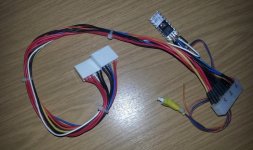philscomputerlab
Experienced Member
Very useful for 386 and 486 machines, when you're using devices that require -5V.
In this video I am reviewing two ATX to AT power adapters. One is cheaper, but does not supply -5V, the other one is more expensive, but has a converter that adds -5V. Some sound cards, like the Roland LAPC-I, Sound Blaster 2 or Pro Audio Spectrum 16 require -5 V.
In the video I'm also showing you what these sound cards sound like if the -5V is missing.
Link to ATX to AT adapter: http://www.ebay.com.au/itm/ATX-to-A...713?pt=LH_DefaultDomain_3&hash=item25a70c4b39
and
http://www.ebay.com.au/itm/NEW-ATX-...WITH-A-DUMMY-LOAD-ON-OFF-SWITCH-/251312860753
Link to one ATX to AT adapter with -5V support:
http://www.ebay.com.au/itm/ATX-20-P...-OFF-SWITCH-DUMMY-LOAD-USA-MADE-/251025150787
Link to four ATX to AT adapters with -5V support: http://www.ebay.com.au/itm/4-PCS-AT...711?pt=LH_DefaultDomain_0&hash=item3ceaad8777
In this video I am reviewing two ATX to AT power adapters. One is cheaper, but does not supply -5V, the other one is more expensive, but has a converter that adds -5V. Some sound cards, like the Roland LAPC-I, Sound Blaster 2 or Pro Audio Spectrum 16 require -5 V.
In the video I'm also showing you what these sound cards sound like if the -5V is missing.
Link to ATX to AT adapter: http://www.ebay.com.au/itm/ATX-to-A...713?pt=LH_DefaultDomain_3&hash=item25a70c4b39
and
http://www.ebay.com.au/itm/NEW-ATX-...WITH-A-DUMMY-LOAD-ON-OFF-SWITCH-/251312860753
Link to one ATX to AT adapter with -5V support:
http://www.ebay.com.au/itm/ATX-20-P...-OFF-SWITCH-DUMMY-LOAD-USA-MADE-/251025150787
Link to four ATX to AT adapters with -5V support: http://www.ebay.com.au/itm/4-PCS-AT...711?pt=LH_DefaultDomain_0&hash=item3ceaad8777

